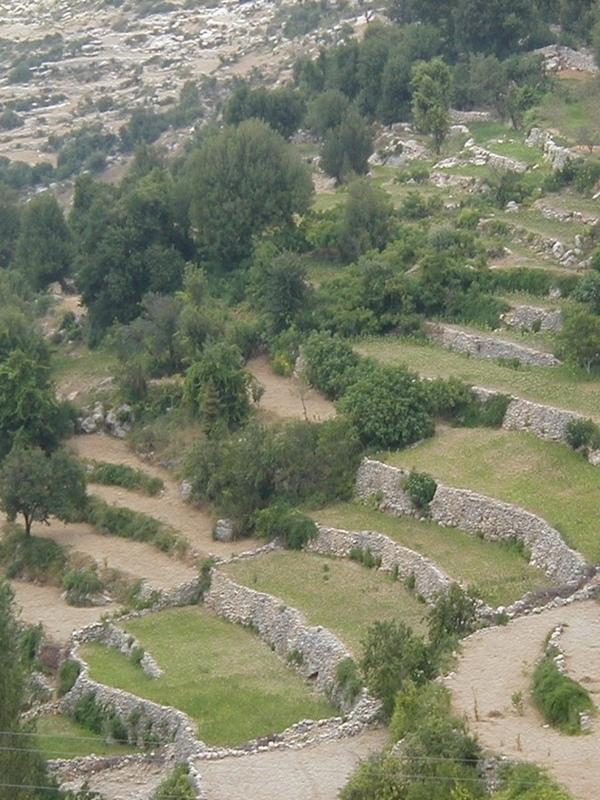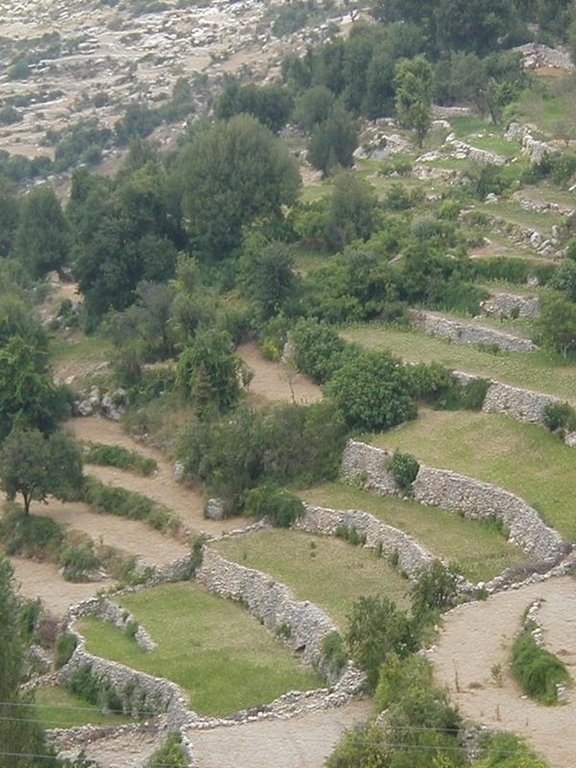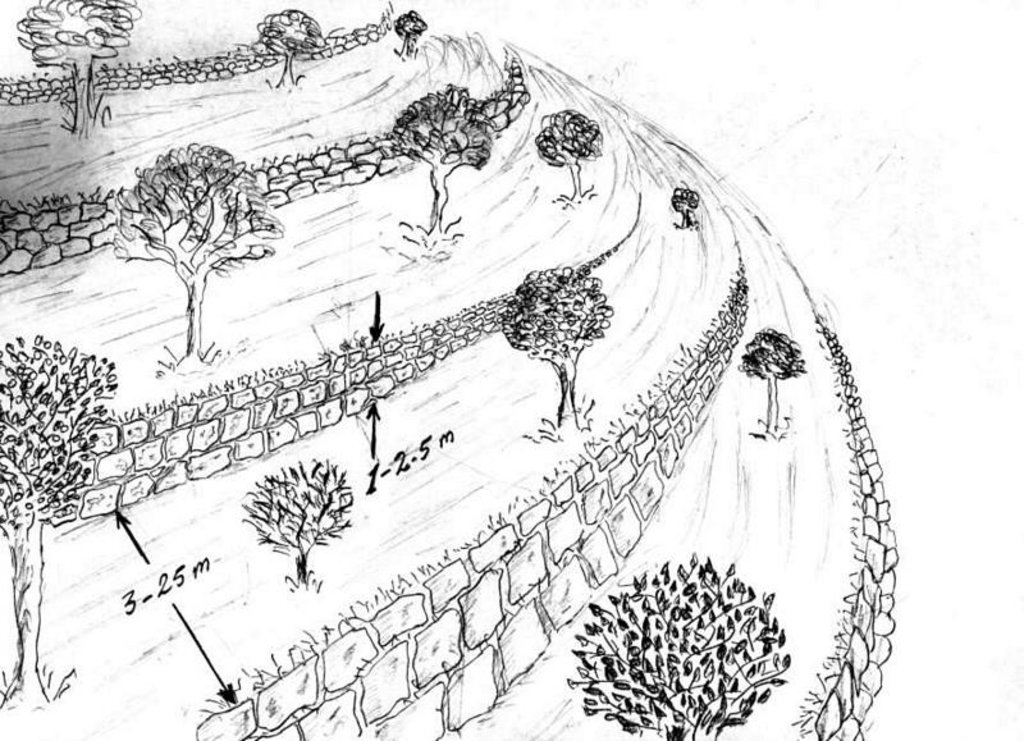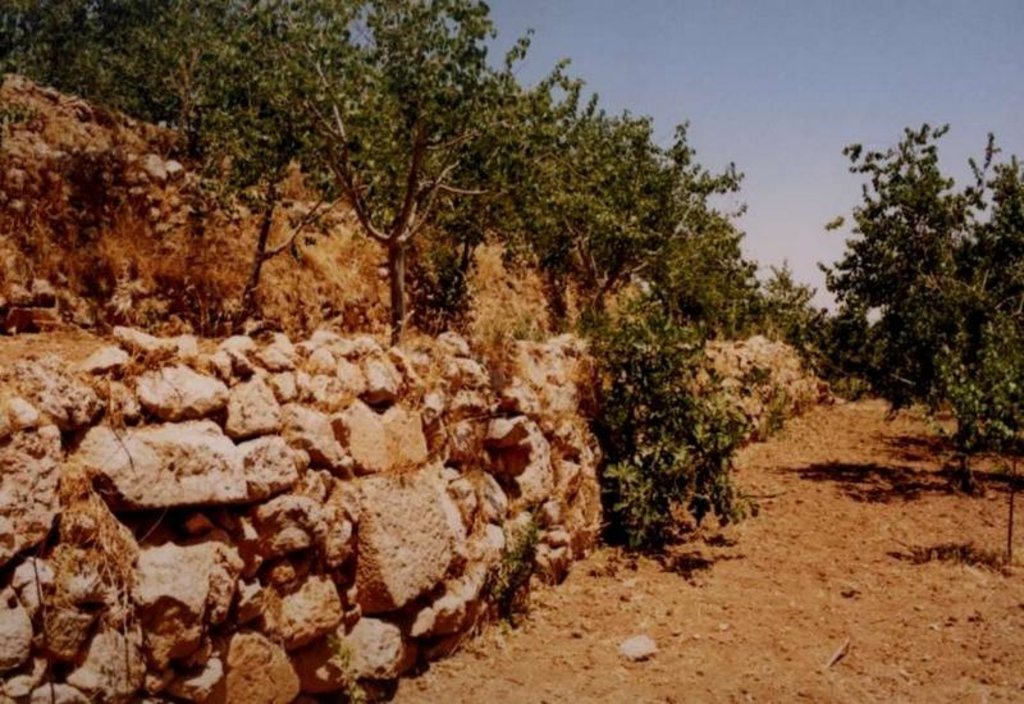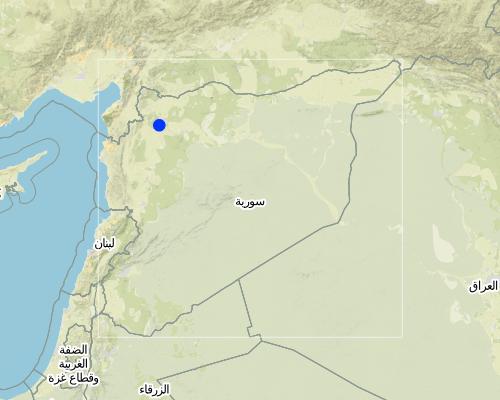Stone Wall Bench Terraces [الجمهورية العربية السورية]
- تاريخ الإنشاء:
- تحديث:
- جامع المعلومات: Michael Zoebisch
- المحرر: –
- المُراجع: Fabian Ottiger
Mudarrajad Hajaria (Arabic)
technologies_1411 - الجمهورية العربية السورية
عرض الأقسام
توسيع الكل طي الكل1. معلومات عامة
1.2 تفاصيل الاتصال بالأشخاص الرئيسيين لمصدر المعلومات والمؤسسات المشاركة في تقييم وتوثيق التقنية
متخصص في الإدارة المستدامة للأراضي:
متخصص في الإدارة المستدامة للأراضي:
متخصص في الإدارة المستدامة للأراضي:
متخصص في الإدارة المستدامة للأراضي:
متخصص في الإدارة المستدامة للأراضي:
Salem Salwa
ICARDA Syria
P.O.Box 5466, Aleppo
الجمهورية العربية السورية
اسم المشروع الذي سهّل توثيق/تقييم التقنية (إذا كان ذلك على صلة)
Book project: where the land is greener - Case Studies and Analysis of Soil and Water Conservation Initiatives Worldwide (where the land is greener)اسم المؤسسة (المؤسسات) التي سهلت توثيق/تقييم التقنية (إذا كان ذلك على صلة)
International Center for Agricultural Research in the Dry Areas (ICARDA) - لبنان1.3 الشروط المتعلقة باستخدام البيانات الموثقة من خلال WOCAT
متى تم تجميع البيانات (ميدانيا)؟:
23/08/1999
يوافق جامع المعلومات والشخص (لاشخاص) الرئيسي لمصدر المعلومات على الشروط المتعلقة باستخدام البيانات الموثقة من خلال WOCAT:
نعم
2. وصف تقنيةالإدارة المستدامي للأراضي
2.1 وصف مختصر للتقنية
تعريف التقنية:
Ancient level bench terraces with stone walls, built to stabilise slopes, retain moisture, and create a suitable environment for horticulture.
2.2 وصف تفصيلي للتقنية
الوصف:
Stone wall bench terraces in the hill ranges of western Syria comprise an ancient indigenous technology, introduced by the Romans and Byzantines about 2,000 years ago. Some new terraces are, however, still being built. The walls are constructed with limestone, largely found on site. The terraces are located in steep terrain (usually on slopes more than 25%) under low (and erratic) rainfall regimes of between 250 and 500 mm per annum. The terrace walls are 1-2.5 m high and the level beds 3-25 m wide, depending on slope.
Deep soil profiles (more than 2 m) have developed on steep slopes, where original soil depth was only shallow to medium. The terraces are very efficient in preventing soil erosion and in the retention of rainfall. They support trees and annual crops where they could not otherwise be grown.
These terraces are usually found near settlements. Construction is very labour intensive, considering how little land is effectively protected from erosion and brought into cultivation. High labour investment makes the construction process slow and retards further extension of the technology. However, if soundly constructed, maintenance requirements are low. Underlining this point, a large number of very ancient terraces can still be found intact, supporting a productive crop. Sometimes localised collapse of a terrace occurs due to concentrated runoff. In that case, the terrace in question may need to be rebuilt. To prevent such breaches, it is important to allow for discharge of excess runoff along drainage lines.
Currently, most terraces are used to grow fruit trees. These include olives, cherries, almonds, plums, pomegranates, apricots, and peaches. Husbandry practices are normally carried out by hand. Where space permits, however, draft animals are used for tillage. The curves of the terraces and access to the steep slopes make it very difficult/impossible to use tractors. Animal power is more versatile in this irregular landscape, but it is more expensive than tractor power, due to shortage of fodder.
2.3 صور التقنية
2.5 البلد/المنطقة/المواقع التي تم تنفيذ التقنية فيها والتي يغطيها هذا التقييم
البلد:
الجمهورية العربية السورية
المنطقة/الولاية/المحافظة:
Idleb Province, Ariha District
مزيد من التفاصيل حول الموقع:
Tal Lata Village
Map
×2.6 تاريخ التنفيذ
في حالة عدم معرفة السنة بالتحديد، يرجى الإشارة إلى التاريخ التقريبي:
- منذ أكثر من 50 عامًا (تقليدي)
2.7 إدخال التقنية
حدد كيف تم إدخال التقنية:
- كجزء من النظام التقليدي (> 50 عامًا)
التعليقات (نوع المشروع، الخ):
The technology was most probably developed and introduced during the Roman/Byzantine period, 200-400 AD
3. تصنيف تقنية الإدارة المستدامي للأراضي
3.1 الغرض الرئيسي ( الأغراض الرئيسية) للتقنية
- تحسين الإنتاج
- خلق أثر اقتصادي مفيد
3.2 نوع (أنواع) استخدام الأراضي الحالية حيث يتم تطبيق التقنية

الأراضي الزراعية
- زراعة الأشجار والشجيرات
المحاصيل الرئيسية (المحاصيل النقدية والغذائية):
Major cash crop: Fruits (olives, cherries, almonds, plums, pomegran
التعليقات:
Major land use problems (compiler’s opinion): Before terracing, water erosion resulted in shallow to medium colluvial soils. Terracing made cultivation possible, but the
beds tend to be very narrow and/or irregularly shaped, with large boulders set in them, making tractor cultivation (which is cheap) impossible.
Major land use problems (land users’ perception): (1) Soil tillage - mechanization is difficult; animal power is up to 5 times more expensive than tractor power.
(2) Rockiness of the soil - large and very large stones make cultivation difficult.
(3) Accessibility - inadequate road network to reach fields
3.3 مزيد من المعلومات حول استخدام الأراضي
إمدادات المياه للأرض التي يتم تنفيذ التقنية عليها:
- بعلية
عدد مواسم الزراعة في السنة:
- 1
حدد:
Longest growing period in days: 180 Longest growing period from month to month: Nov - Apr
3.4 مجموعةالإدارة المستدامة للأراضي التي تنتمي إليها هذه التقنية
- التدابير المتقاطعة للمنحدرات
3.5 انتشار التقنية
حدد انتشار التقنية:
- منتشرة بالتساوي على مساحة
إذا كانت التقنية منتشرة بالتساوي على منطقة ما، فحدد المنطقة التقريبية المغطاة:
- 10-1 كم2
التعليقات:
Total area covered by the SLM Technology is 5 km2.
Recently, new stone wall bench terraces have been constructed in the villages of Mnabe and Bzbour (Ariha District)
3.6 التدابير التقنية في مجال إلادارة المستدامة للأراضي
3.7 الأنواع الرئيسية من تدهور الأراضي التي تناولتها التقنية

تآكل التربة بالمياه
- الوزن(Wt): فقدان التربة السطحية/تآكل السطح

تدهور المياه
- (Ha): التجفيف
التعليقات:
Main type of degradation addressed: Wt: loss of topsoil / surface erosion, Ha: aridification
3.8 منع أو حد أو عكس تدهور الأراضي
تحديد هدف التقنية فيما يتعلق بتدهور الأراضي:
- منع تدهور الأراضي
4. المواصفات الفنية، وأنشطة التنفيذ، والمدخلات، والتكاليف
4.1 الرسم الفني للتقنية
4.2 المواصفات الفنية/شروحات الرسم الفني
Stone wall risers constructed in ancient times: these hold back the earth for production of fruit trees on the level benches.
Technical knowledge required for field staff / advisors: high
Technical knowledge required for land users: high
Main technical functions: reduction of slope angle, increase of infiltration, water harvesting / increase water supply, increase in soil fertility (long-term)
Secondary technical functions: increase / maintain water stored in soil, sediment retention / trapping, sediment harvesting, control of concentrated runoff
Terrace: bench level
Vertical interval between structures (m): 1-2
Spacing between structures (m): 2-25
Construction material (stone): natural stones (limestone)
Slope (which determines the spacing indicated above): 20%
For water harvesting: the ratio between the area where the harvested water is applied and the total area from which water is collected is: 1:1
4.3 معلومات عامة بخصوص حساب المدخلات والتكاليف
عملة أخرى/ عملة وطنية (حدد):
Syrian Pounds
أشر إلى سعر الصرف من الدولار الأمريكي إلى العملة المحلية (إذا كان ذا صلة): 1 دولار أمريكي =:
50,0
اذكر متوسط تكلفة أجر العمالة المستأجرة في اليوم الواحد:
3.00
4.4 أنشطة التأسيس
| النشاط | نوع التدبير | التوقيت | |
|---|---|---|---|
| 1. | Levelling the terrace bed by bulldozers where necessary. | بنيوية أو هيكلية | 0.35-0.7 persondays/m for all activities |
| 2. | Blasting rocks in the field | بنيوية أو هيكلية | |
| 3. | Collecting stones for wall building – which are available locally. | بنيوية أو هيكلية | |
| 4. | Building the stone walls with 1–2.5 m vertical interval (and therefore | بنيوية أو هيكلية | |
| 5. | Levelling land between stone walls. | بنيوية أو هيكلية |
4.5 التكاليف والمدخلات اللازمة للتأسيس
| تحديد المدخلات | الوحدة | الكمية | التكاليف لكل وحدة | إجمالي التكاليف لكل مدخل | % من التكاليف التي يتحملها مستخدمو الأراضي | |
|---|---|---|---|---|---|---|
| العمالة | Labour | ha | 1,0 | 1260,0 | 1260,0 | 100,0 |
| العمالة | Stone collection | ha | 1,0 | 50,0 | 50,0 | 100,0 |
| معدات | Machine use | ha | 1,0 | 50,0 | 50,0 | 100,0 |
| معدات | Tools | ha | 1,0 | 50,0 | 50,0 | 100,0 |
| معدات | Drill | ha | 1,0 | 5,0 | 5,0 | 100,0 |
| الأسمدة والمبيدات الحيوية | Ammonium nitrate(kg) | ha | 1,0 | 15,0 | 15,0 | 100,0 |
| مواد البناء | Stone | ha | 1,0 | |||
| مواد البناء | Detonators | ha | 1,0 | 10,0 | 10,0 | 100,0 |
| مواد البناء | Fuses (m) | ha | 1,0 | 20,0 | 20,0 | 100,0 |
| إجمالي تكاليف إنشاء التقنية | 1460,0 | |||||
التعليقات:
Duration of establishment phase: 6 month(s)
4.6 الصيانة/الأنشطة المتكررة
| النشاط | نوع التدبير | التوقيت/الوتيرة | |
|---|---|---|---|
| 1. | Repairing (replacing stones) | بنيوية أو هيكلية | 5 persondays required/every year |
4.7 التكاليف والمدخلات اللازمة للصيانة/للأنشطة المتكررة (سنويًا)
| تحديد المدخلات | الوحدة | الكمية | التكاليف لكل وحدة | إجمالي التكاليف لكل مدخل | % من التكاليف التي يتحملها مستخدمو الأراضي | |
|---|---|---|---|---|---|---|
| العمالة | Labour | ha | 1,0 | 15,0 | 15,0 | 100,0 |
| معدات | Tools | ha | 1,0 | 5,0 | 5,0 | 100,0 |
| مواد البناء | Stone | ha | 1,0 | |||
| إجمالي تكاليف صيانة التقنية | 20,0 | |||||
التعليقات:
Manual construction work requires 0.35-0.7 person days per metre length of terrace wall. Establishment costs were calculated for an average of 600 m length of stone wall (height 2 m, width 70 cm) per hectare on a 12% slope, with
terrace beds therefore about 16-17 metres wide. Narrower terraces on steeper slopes are considerably more expensive to construct.
4.8 أهم العوامل المؤثرة على التكاليف
قدم وصفا لأهم العوامل التي تؤثر على التكاليف:
Labour shortage and labour cost
5. البيئة الطبيعية والبشرية
5.1 المناخ
هطول الأمطار السنوي
- < 250 مم
- 251- 500 ملم
- 501 - 750ملم
- 1,000-751 ملم
- 1,500-1,100 ملم
- 2,000-1,500 ملم
- 3,000-2,001 ملم
- 4,000-3,100 ملم
- > 4000 ملم
المنطقة المناخية الزراعية
- شبه قاحلة
5.2 طوبوغرافيا
متوسط الانحدارات:
- مسطح (0-2%)
- بسيط (3-5%)
- معتدل (6-10%)
- متدحرج (11-15%)
- تلال (16-30%)
- شديدة الانحدار(31-60%)
- فائقة الانحدار (>60%)
التضاريس:
- هضاب/سهول
- أثلام مرتفعة
- المنحدرات الجبلية
- منحدرات التلال
- منحدرات في السفوح
- قاع الوادي
المنطقة الارتفاعية:
- 100-0 متر فوق سطح البحر
- 500-101 متر فوق سطح البحر
- 1,000-501 متر فوق سطح البحر
- 1,500-1,001 متر فوق سطح البحر
- 2,000-1,501 متر فوق سطح البحر
- 2,500-2,100 متر فوق سطح البحر
- 3,000-2,501 متر فوق سطح البحر
- 4,000-3,001 متر فوق سطح البحر
- > 4000 متر فوق سطح البحر
التعليقات والمواصفات الإضافية بشأن التضاريس:
Slopes on average: Also rolling (ranked 3)
5.3 التربة
متوسط عمق التربة:
- ضحل جدًا (0-20 سم)
- ضحلة (21-50 سم)
- متوسطة العمق (51-80 سم)
- عميقة (81-120 سم)
- عميقة جدًا (> 120 سم)
قوام التربة (التربة السطحية):
- متوسط ( طميي، سلتي)
- ناعم/ثقيل (طيني)
المواد العضوية في التربة السطحية:
- متوسطة (1-3%)
إذا كان متاحًا، قم بإرفاق وصف كامل للتربة أو تحديد المعلومات المتوفرة، على سبيل المثال نوع التربة، الرقم الهيدروجيني/ درجة حموضة التربة، قدرة التبادل الكاتيوني، النيتروجين، الملوحة وما إلى ذلك.
Soil fertility: Medium (ranked 1) and low (ranked 2)
Soil drainage/infiltration: Medium
Soil water storage capacity: Medium
5.6 خصائص مستخدمي الأراضي الذين يطبقون التقنية
التوجه السوقي لنظام الإنتاج:
- مختلط (كفاف/ تجاري)
- تجاري/سوق
الدخل من خارج المزرعة:
- >50% من إجمالي الدخل
مستوى المكننة:
- عمل يدوي
- الجر الحيواني
اذكر الخصائص الأخرى ذات الصلة لمستخدمي الأراضي:
Population density: > 500 persons/km2
Annual population growth: 3% - 4%
Relative level of wealth: very rich, rich, average, poor
3% of the land users are very rich and own 20% of the land (very few).
7% of the land users are rich and own 20% of the land (few,).
40% of the land users are average wealthy and own 30% of the land (Many).
50% of the land users are poor and own 30% of the land (Many).
Off-farm income specification: On average, 70 % of the income is from off-farm activities
5.7 متوسط مساحة الأرض المملوكة أو المستأجرة من قبل مستخدمي الأراضي الذين يطبقون التقنية
- < 0.5 هكتارا
- 0.5 - 1 هكتار
- 1 -2 هكتار
- 2 - 5 هكتار
- 5 - 15 هكتار
- 15 - 50 هكتار
- 50 - 100هكتار
- 500-100 هكتار
- 1,000-500 هكتار
- 10,000-1,000 هكتار
- > 10,000 هكتار
التعليقات:
The overall range is 0.5-7 ha
5.8 ملكية الأراضي، وحقوق استخدام الأراضي، وحقوق استخدام المياه
ملكية الارض:
- فردية، يوجد سند ملكية
حقوق استخدام الأراضي:
- فردي
6. الآثار والتصريحات الختامية
6.1 الآثار التي أظهرتها التقنية في الموقع
الآثار الاجتماعية والاقتصادية
الإنتاج
إنتاج المحاصيل
جودة العلف
إنتاج الخشب
إدارة الأراضي
الدخل والتكاليف
دخل المزرعة
عبء العمل
التعليقات/ حدد:
Mechanisation is not possible
الآثار الاجتماعية والثقافية
المؤسسات المجتمعية
المؤسسات الوطنية
التخفيف من حدة الصراع
التعليقات/ حدد:
But a potential for conflict if the community refuses to participate in joint maintenance activities
الآثار الايكولوجية
دورة المياه / الجريان السطحي
تصريف المياه الزائدة
التربة
رطوبة التربة
غطاء التربة
فقدان التربة
دورة المغذيات/إعادة الشحن
التنوع البيولوجي: الغطاء النباتي، الحيوانات
التنوع النباتي
التنوع الحيواني
تنوع الموائل
الحد من مخاطر المناخ والكوارث
سرعة الرياح
6.2 الآثار التي أظهرتها التقنية خارج الموقع
الفيضان في اتجاه مجرى النهر
تراكم الطمي باتجاه مصب النهر
تلوث المياه الجوفية/الأنهار
6.4 تحليل التكلفة والعائد
كيف يمكن مقارنة العوائد نسبة لتكاليف الإنشاء (من وجهة نظر مستخدمي الأراضي)؟
عوائد قصيرة الأجل:
سلبي
عوائد طويلة الأجل:
إيجابي
كيف تتم مقارنة العوائدمع كلفة الصيانة/التكاليف المتكررة (من وجهة نظر مستخدمي الأراضي)؟
عوائد قصيرة الأجل:
إيجابي
عوائد طويلة الأجل:
إيجابي
6.5 اعتماد التقنية
إذا كان متاحًا، قم بتحديد الكمية (عدد الأسر المعيشية و/أو المساحةالمغطاة):
39
التعليقات:
5% of land user families have adopted the Technology with external material support
2 land user families have adopted the Technology with external material support
95% of land user families have adopted the Technology without any external material support
37 land user families have adopted the Technology without any external material support
There is no trend towards spontaneous adoption of the Technology
Comments on adoption trend: The rate of spontaneous adoption is low because of the high costs.
6.7 نقاط القوة / المزايا / الفرص التي توفرها التقنية
| نقاط القوة/ المزايا/ الفرص من وجهة نظر جامع المعلومات أو غيره من الاشخاص الرئيسيين لمصدر المعلومات |
|---|
|
Soil and water is conserved and fruit crop yields are maintained/increased How can they be sustained / enhanced? Combine with soil fertility improvement (such as farm yard manure). The prices of the crops grown should remain adequate |
|
The maintenance requirements are low. The terraces need little repair How can they be sustained / enhanced? Natural drainage lines must be prepared/maintained to prevent collapse during heavy rainfall. |
| The terraces make the cultivation of trees on hill slopes possible. |
6.8 نقاط ضعف / مساوىء / مخاطر التقنية وسبل التغلب عليها
| نقاط الضعف/ المساوىء/ المخاطر من وجهة نظر جامع المعلومات أو غيره من الاشخاص الرئيسيين لمصدر المعلومات | كيف يمكن التغلب عليها؟ |
|---|---|
| The establishment costs are high | Plant high value cash crops. |
| The mechanisation of farm operations is impossible because there is no access to the terraces for tractors, while animal power is constrained by high maintenance costs (fodder). Thus, field operations are limited to hand labour | Subsidise mule ploughing. |
7. المراجع والروابط
7.2 المراجع للمنشورات المتاحة
العنوان، المؤلف، السنة، النظام القياسي الدولي لترقيم الكتب ISBN:
Mushallah AB. The visible and the hidden in the country of olives. pp 463. 2000.
متاح من أين؟كم التكلفة؟:
Akrama Publ. Office. Damascus, Syria.
الروابط والوحدات المواضيعية
توسيع الكل طي الكلالروابط
لا يوجد روابط
الوحدات المواضيعية
لا يوجد وحدات مواضيعية


